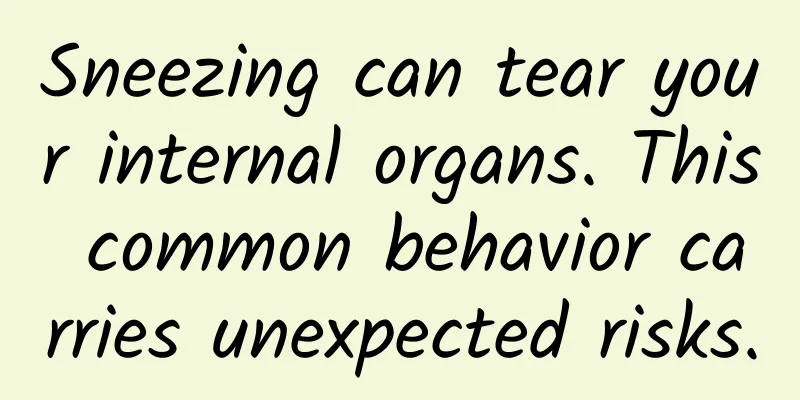What should I do if my voice becomes hoarse after thyroidectomy?

|
In recent years, as people's health awareness continues to increase, the detection rate of thyroid cancer has increased year by year. Thyroidectomy is the most common treatment method, and postoperative recovery is also a concern for everyone. Today we will talk about what to do if your voice becomes hoarse after thyroidectomy? Below I will introduce from multiple angles how to deal with hoarseness after thyroidectomy. 1. Sore throat and hoarseness caused by intubation after thyroid surgery Normally, thyroid surgery requires general anesthesia and endotracheal intubation, and sore throat is caused by throat damage caused by the endotracheal intubation operation, which makes the patient afraid to swallow and pronounce words forcefully. If this happens, the patient can take lozenges to clear the throat orally, and the diet should be light. Spicy and irritating foods should be avoided. Eat more foods that can eliminate accumulation, reduce swelling, and enhance immunity. Be careful not to smoke or drink on a daily basis, rest more, drink more water, and talk less. Generally, the sore throat will recover quickly, and the voice will recover as well. 2. Voice disorders caused by recurrent laryngeal nerve damage after thyroid surgery About 25%-90% of patients will experience voice disorders after thyroidectomy, which are mainly manifested by fatigue during pronunciation, low voice, difficulty reaching high notes, and difficulty singing. Common causes include abnormal glottal closure caused by unilateral recurrent laryngeal nerve damage caused by intraoperative thermal burns, clamping, and traction of the recurrent laryngeal nerve. Some patients, although there is no recurrent laryngeal nerve damage during surgery, still have abnormal voice manifestations such as hoarseness and difficulty speaking after surgery. As the surgical site improves, local congestion disappears, and the stimulation of the recurrent laryngeal nerve decreases, it can return to normal. Patients with mild symptoms need 3-6 months to restore their voice, and the longest time is about a year. Abnormal voice can have serious adverse effects on patients' daily lives, including decreased communication skills, difficulty maintaining interpersonal relationships, etc., leading to a decrease in their quality of life and a serious negative impact on patients' mental health. 3. Methods for voice recovery Voice training is an important treatment for patients with voice disorders. Its principle is to enable patients to fully learn and use scientific vocalization methods to relax the strained muscles of the throat, allowing them to recover naturally or compensate with the healthy vocal cords, increase the elasticity of the vocal cords, promote vocal cord closure, thereby improving the patient's pronunciation quality and improving the abnormal state of the voice. It is a non-invasive treatment method with the characteristics of low cost, simple operation, non-invasiveness and high patient acceptance. The following are some methods of voice recovery: (1) Pay attention to voice hygiene: This mainly includes eating a light and healthy diet, maintaining the humidity and temperature of the living environment, and having a regular lifestyle, avoiding tobacco and alcohol intake, and avoiding fatigue. It is recommended that patients wear masks when going outdoors or in environments with high dust concentrations to prevent air irritation. It is recommended that patients listen to music or watch movies to relax when resting at home. (2) Relaxation training: It depends on the specific recovery of the patient. After thyroidectomy, patients are not suitable for relaxation methods such as neck muscle massage, excessive head tilt, and head shaking to avoid complications such as wound bleeding and rupture after thyroidectomy. Sit down and let the patient relax their neck, shoulders, and back. Play soothing music for the patient. The patient should consciously control and relax the muscles to reduce the discomfort of the patient when speaking, such as symptoms such as whole body muscle tension. Relaxation training usually lasts about 5 minutes. (3) Breathing training: mainly abdominal breathing: guide the patient to inhale slowly through the nose and then exhale slowly and evenly through the mouth for 5 minutes. During the inhalation process, the abdominal wall bulges and the diaphragm descends. During the exhalation process, the abdominal wall sinks and the diaphragm rises. Use the strength of the abdominal muscles to increase abdominal pressure and assist breathing, so that exhalation changes from passive to active, and provide sufficient air flow to support pronunciation. You can use the method of blowing "silk" in one breath, blowing candles, dog panting, counting in one breath, or the "blowing balloon" method. The patient places both hands on the lower abdomen on both sides and blows a balloon. While exhaling steadily and continuously, use both hands to feel the steady and powerful muscle contraction of the lower abdomen inward. (4) Pronunciation training: Glottal closure training: patients can cough or laugh; pant with the "ho" sound; inhalation pronunciation: sound is made when inhaling; plosive sound training: the mouth is closed first, and then the airflow breaks through the obstruction and blasts the sound. "P" is a voiceless consonant, and the vocal cords do not vibrate; "b" is a voiced consonant, and the vocal cords vibrate, and so on "t", "d", "k", "g"; root of tongue sound training: pronounce "g", "k", "h" sounds; push heavy objects and pronounce "g" at the same time. Maintain vocal cord tension training: glissando training: cooperate with gurgling, blow from the highest to the lowest, and then blow from the lowest to the highest; inhalation pronunciation; straw blowing training: take a straw, put one end in water, hold the straw in your mouth and blow air to relax the vocal cords, inhale through your nose, contract your abdomen for 10 counts, and then make a "wu" sound, and then you can practice glissando from low to high and from high to low. (5) Cavity resonance: Chewing and humming allow the patient to make the mu sound and feel the vibration of the upper lip; blowing and straw practice. You can try to practice the above method. Note that abdominal breathing is the basis. Practicing abdominal breathing more often has many benefits. It is recommended that you use straw blowing and suction exercises. This method is simple and effective. You can start practicing one day after the operation. Blowing and suction tube exercises should be 3-5 minutes each time, 5-7 times a day, based on the patient not being tired. Patients with moderate to severe hoarseness or high demands on the voice can also go to a special voice clinic for professional rehabilitation treatment. 4. Tips on eating methods Hoarseness caused by recurrent laryngeal nerve injury is often accompanied by swallowing disorders, mainly choking and coughing when drinking water. Its pathogenesis is mainly caused by incomplete glottis closure and leakage of liquid into the trachea during swallowing. Studies have shown that even 18-24 months after thyroidectomy, the swallowing impairment scores (SIS) evaluation of swallowing results are still significantly different from those before surgery. Therefore, swallowing dysfunction in patients after thyroidectomy may persist to varying degrees from 1 week to 2 years after surgery. In the postoperative dietary recovery of thyroidectomy patients, repeated saliva swallowing tests, Kubota drinking water tests, etc. can be used to improve the assessment of the patient's swallowing function, and then make more reasonable arrangements for follow-up care and dietary guidance. The voice training introduced earlier can also help patients close the glottis when holding their breath, strengthen the closing function of the airway, and make it easier for the food bolus to be transported from the pharynx to the esophagus. It can help patients master the correct eating method and speed up the recovery time of patients' eating. In summary, although hoarseness is a problem that bothers patients after thyroid surgery, as long as you understand the above causes of hoarseness and voice training methods, you can quickly restore your voice function! (Li Yan, Cancer Hospital, Chinese Academy of Medical Sciences) |
>>: Why can we see more clearly when we squint?
Recommend
Where is the cheapest Maxmara coat? When is the best season to buy Maxmara coat?
MaxMara coats are super popular, and many people ...
How to prevent pelvic inflammatory disease, do this to stay away from pelvic inflammatory disease
Pelvic inflammatory disease is a gynecological di...
What does the ovarian dark area mean?
For the health of the ovaries, you must do a good...
Can I use Red Core Fujie Wash during menstruation?
Honghe Fujie Wash is a vaginal cleansing medicine...
How long after giving birth can I breastfeed?
Breastfeeding is a feeding method chosen by many ...
What does it mean to "please be busy first"? How to reply
Because of chat tools like WeChat and QQ, many pe...
Do men and women need to talk about their relationship? What does it mean for a man and a woman to be in a formal relationship?
During adolescence, many men and women don't ...
Which one has higher protein content, milk or soy milk? What is the fastest way to supplement protein?
Our body's need for protein depends not only ...
What to do if your face is swollen during pregnancy
When a woman becomes pregnant, her body will unde...
What should women pay attention to after menopause
Menstruation every month can make people feel ver...
In early spring, all kinds of diseases will arise! Do these 6 things regularly to regulate the liver, spleen and blood ~
Late winter and early spring are the times when d...
What are the causes of cysts in women?
Ovarian cyst is a relatively common gynecological...
Newlyweds must master this knowledge
If newlyweds do not want to get pregnant after ma...
Normal female anal structure
The anal structure of normal women and men is dif...
Pre-hospital treatment of severed fingers
Finger amputation is a common accidental injury. ...








